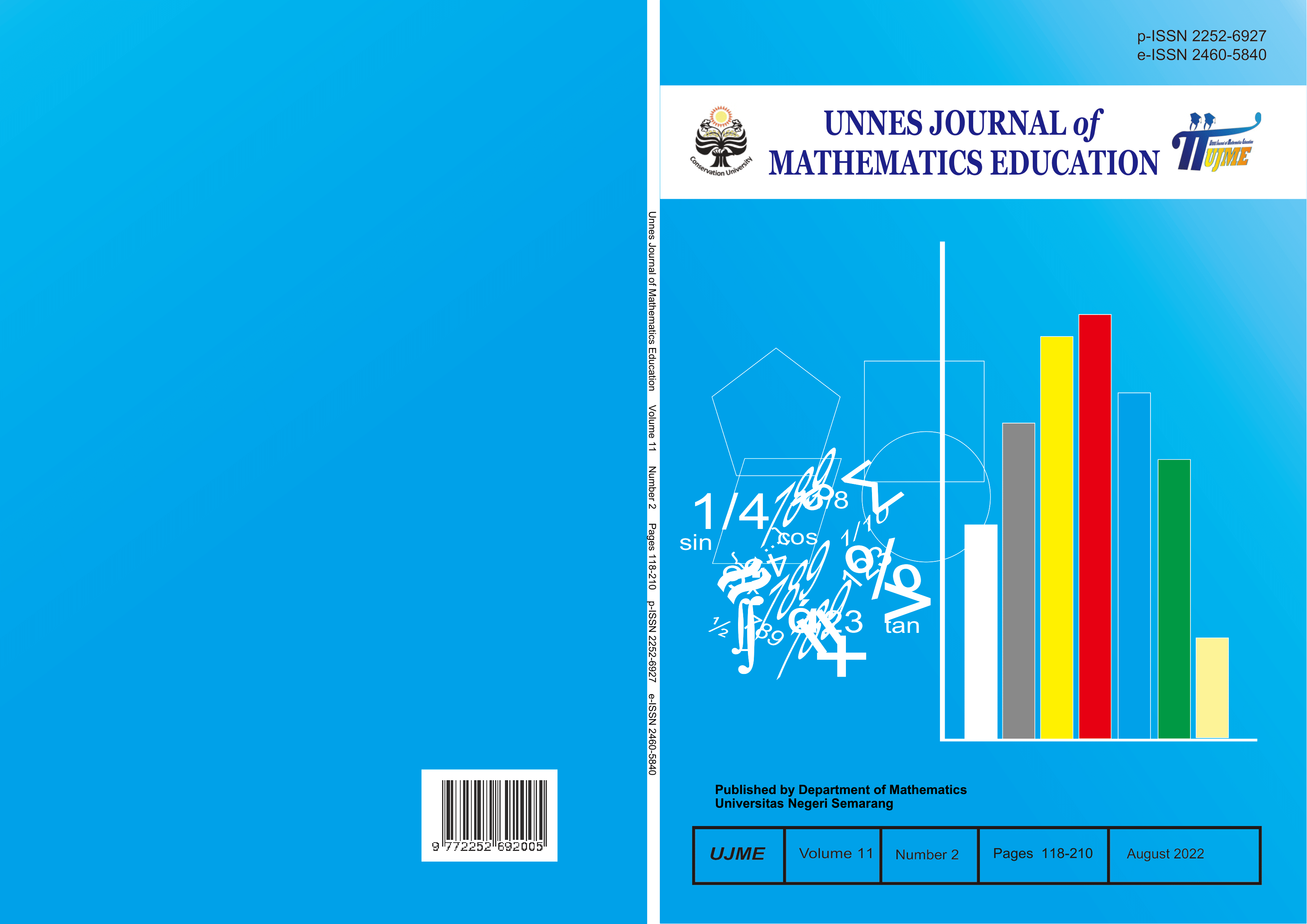Analysis of Mathematical Reasoning Ability of Eight Grade on CORE Learning Model in terms of Thinking Style
##plugins.themes.academic_pro.article.main##
Abstract
This study aimed to determine the effectiveness of the CORE learning model toward students’ mathematical reasoning ability and describe the students’ mathematical reasoning ability through the application of the CORE learning model in terms of students’ thinking styles. This study used a mixed method with a concurrent embedded strategy and posttest-only control group design. The population in this study were the eight grade students of SMP Negeri 2 Patebon. Samples were taken by using a simple random technique and obtained VIII A class as an experimental and VIII C as a control class. Subjects of this study were determined by using the purposive technique and obtained two students from each thinking style category. Data collection techniques in this study were a test, questionnaire, interview, and documentation. The quantitative data analysis of this study used both initial and research data. Research data analysis consists of individual completeness tests, classical completeness tests, average difference tests, and proportional difference tests. Before testing the effectiveness of learning, the prerequisite test is conducted first, namely the normality and homogeneity test. The qualitative data analysis technique was carried out by using qualitative descriptive methods, including data reduction, data display, and conclusion drawing. The results showed that (1) the implementation of the CORE learning model is effective towards students’ mathematical reasoning ability; and (2) subject with concrete sequential have good ability in mathematical reasoning; subject with abstract sequential tends to be very good in mathematical reasoning ability; subject with concrete random tends to be good in mathematical reasoning ability; subject with abstract random tends to have the low ability in mathematical reasoning.
##plugins.themes.academic_pro.article.details##
References
Ayal et al. (2016). The Enhancement of Mathematical Reasoning Ability of Junior High School Students by Applying Mind Mapping Strategy. Journal of Education and Practice, 7(25), 50-52.
Calfee, R. C. et al. (2010). Increasing Teachers‟ Metacognition Develops Students‟ Higher Learning during Content Area Literacy Instruction: Finding from the Read-Write Cycle Project. Issues in Teacher Education, 19(2): 127-151.
DePorter, B. & M. Hernacki. (2008). Quantum Learning: Membiasakan Belajar Nyaman dan Menyenangkan. Bandung: Kaifa.
Fonseca, L . (2018). Mathematical Reasoning and Proof Schemes in the Early Years. Journal of European Teacher Education Network, 13: 34-44.
Kusumawardani, D. R., Wardono, & Kartono. (2018). Pentingnya Penalaran dalam Meningkatkan Kemampuan Literasi Matematika. In Prosiding Seminar Nasional Matematika. Semarang.
Lestanti, M. M., Isnarto, & Supriyono. (2016). Analisis Kemampuan Pemecahan Masalah Ditinjau dari Karakteristik Cara Berpikir Siswa dalam Pembelajaran Model Problem Based Learning. Unnes Journal of Mathematics Education, 5(1): 16-23.
Ma’rufi. (2011). Kemampuan Matematika dan Gaya Berpikir Mahasiswa. Jurnal Dinamika, 2(2): 28-44.
Ningsih et al. (2019). Study on the Effect of CORE (Connecting, Organizing, Reflecting and Extending) Learning Model on Mathematics Learning Outcomes of cognitive Domain. Universal Journal of Educational Research, 7(11) : 2463-2471.
OECD. (2019). PISA 2018 Result. https://www.oecd.org/pisa/publications/PISA2018_CN_IDN.pdf.
Putra, Y. S. W. & Mashuri. (2016). Kemampuan Koneksi Matematis Dan Kedisiplinan Pada Implementasi Model Pembelajaran CORE. In Prosiding Seminar Nasional Matematika X Universitas Negeri Semarang. Semarang.
Rifa’i, A & C.T. Anni. (2011). Psikologi Pendidikan. Semarang: Universitas Negeri Semarang.
Sahatcija, R., A. Ora., & A. Ferhataj. (2017). The Impact of the Thinking Style on Teaching Methods and Academic Achievement. European Scientific Journal, 13(34): 16-29.
Siagian, M. D. (2016). Kemampuan Koneksi Matematik dalam Pembelajaran Matematika. Journal of Mathematics Education and Science, 2(1): 58-67.
Sugiyono. (2015). Metode Penelitian Kombinasi (Mixed Method). Bandung: Alfabeta.
Sutriningsih. (2015). Model Pembelajaran Team Assisted Individualization Berbasis Assessment For Learning Pada Persamaan Garis Lurus Ditinjau Dari Gaya Berpikir. Jurnal e-DuMath, 1(1): 43-51.
Tobias, C. U. (2013). Cara Mereka Belajar. Jakarta: Pionir Jaya.
Toktarova.Vera I. & Panturova, Aleksandra A. (2015). Learning and Teaching Style Models in Pedagogical Design of Electronic Educational Environment of the University. Mediterranean Journal of Social Sciences, 6(3): 2039-2117.
Wardhani. (2011). Instrumen Penilaian Hasil Belajar Matematika SMP : Belajar dari PISA dan TIMSS. Yogyakarta: Pusat Pengembangan dan Pemberdayaan Pendidik dan Tenaga Kependidikan Matematika.
Zollinger & Martinson. (2010). Do all Designer Think Alike? What Researcher Has to Say. Institute for Learning Styles Journal Vol 1, 1-15.
